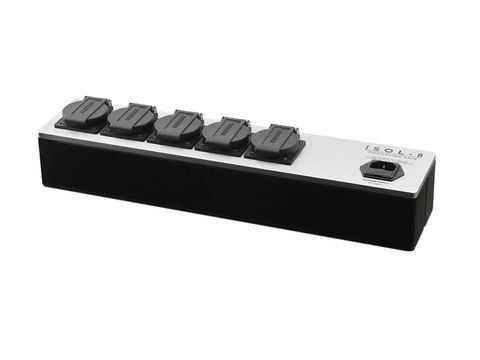TechRadar Verdict
Results vary a little, but good-quality audio electronics can benefit from its use
Pros
- +
Addresses a problem most mains filters don't recognise
- +
Good performance
Cons
- -
Hum reduction with budget kit, though not a fault of the Axis
Why you can trust TechRadar
Mains treatment specialist Isol-8 has been around for quite a while, but has not been over-keen to offer product for review. Evidently, the reason for this decision was due to the fact that advanced sales had outstripped supply, apparently!
Now that this problem has been addressed, we've finally been able to get our hands on a sample of the PowerLine Axis, and a fascinating product it is, too.
In its basic form, the PowerLine is 'just' a mains distribution board – though it's actually about as deluxe as such a thing can get, with silver-plated wiring, high-quality sockets, a solid metal chassis and so on.
But the Axis variant adds something very unusual in mains filtering called DC blocking.
Zero hero
When mains 'noise' is discussed, the term is almost invariably used to mean high frequencies that shouldn't be there. The Axis, however, deals with the other extreme of the spectrum: DC, or 'zero-Hz'.
Theoretically, the signal on the mains is pure AC at 50Hz, but for various reasons to do with non-linearity of equipment connected to the mains, there is often a noticeable amount of DC present. It's nothing like the 240V of 50Hz, more likely to be between a tenth of a volt and (at worst) one volt, but it's enough to give trouble.
Magnetic attraction
The problem is that most audio equipment is powered through a transformer, a device that turns electricity into magnetism and back again and in the process alters voltage and current levels. This works very well with AC, but because it relies intrinsically on a changing magnetic field, it doesn't work at all with DC.
What's worse is that mains transformers have very low tolerance of DC, because they basically consist of a low-resistance coil of wire between live and neutral pins of the plug. A small voltage will cause quite a lot of current to flow. In turn, that upsets the magnetic properties of the transformer, making it less good at performing its official function.
Often the directly perceptible result of this, is that the transformer will hum mechanically. Many transformers do this anyway, but a small amount of DC can make it a lot more noticeable. Simultaneously, the electrical performance of the transformer suffers due to the 'magnetic saturation' and the end result of this is, in many ways, similar to the effects of high-frequency interference.
In other words, DC is potentially just as important a problem as more familiar forms of noise.
Isol-8's solution to it is a surprisingly simple circuit which, however, does exactly what's claimed, re-establishing correct AC-only conditions so that transformers can work at their optimum.
Back to basics
Keen to try it out under the broadest range of conditions, we plugged just about every bit of equipment we could lay our hands on into the Axis, singly and in multiples, and were distinctly impressed with the results.
Ironically, some of the transformers that show the most marked reduction in mechanical buzzing are in the cheapest kit. You'd hardly justify £500 worth of mains filter with a £200 component, though!
Upmarket components benefit in the same way, to a slightly lesser extent, and also show some intriguing improvements in basic sound quality.
Less effort
With the Axis in use, there's no huge change in tonality, but detail becomes subtly clearer and better defined and one feels that less effort is required to hear 'into' a recording.
If this is typical – and the range of equipment we tried suggests it is – DC filtering could be the next big thing in audio tweakery!
Follow TechRadar Reviews on Twitter: http://twitter.com/techradarreview

